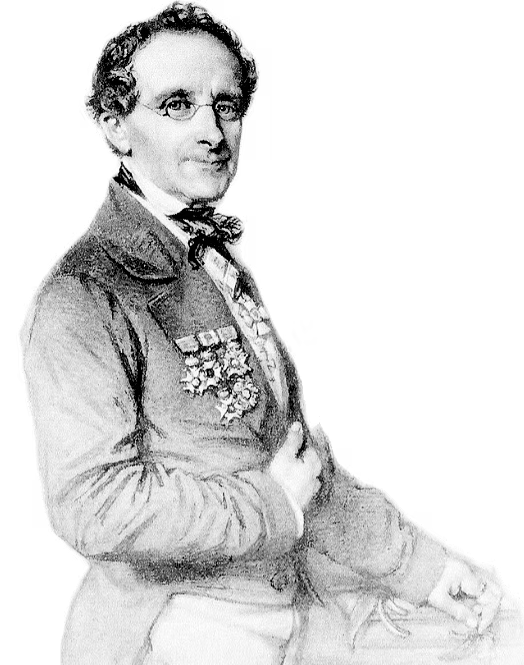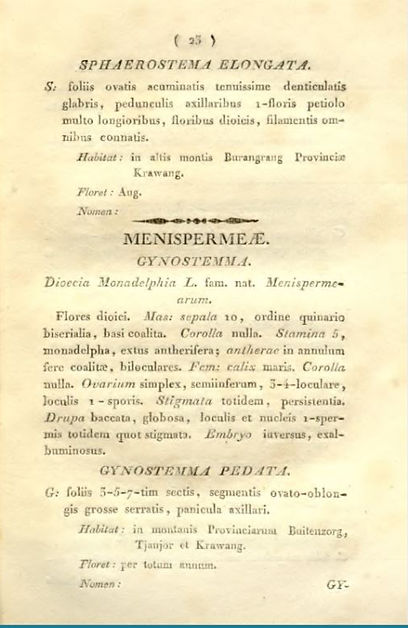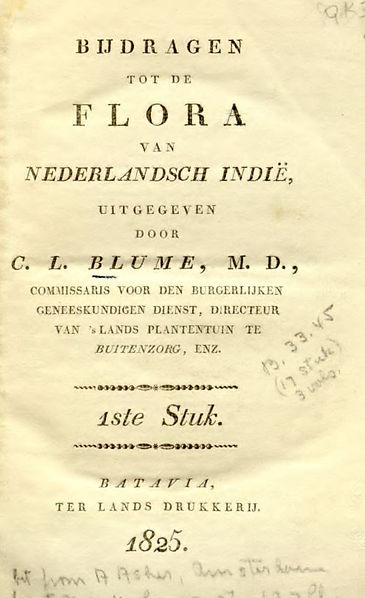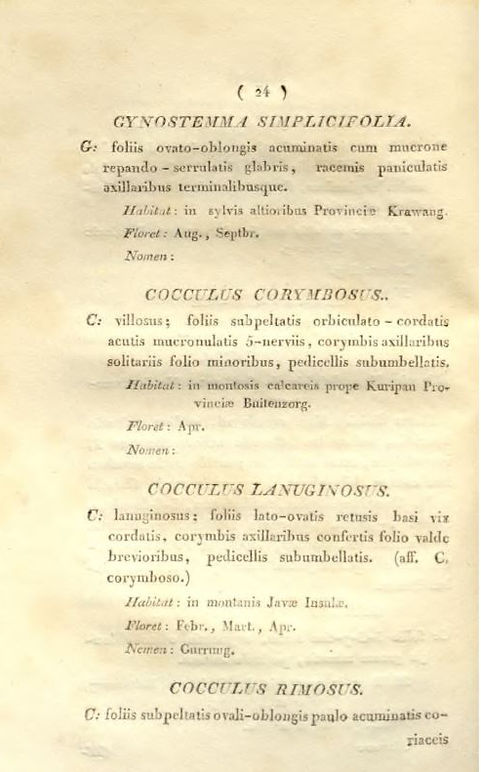Carl Ludwig Blume
Der deutsche Botaniker, der Gynostemma pentaphyllum der Wissenschaft erschloss (1796-1862)

Carl Ludwig Blume (1796-1862) — Deutscher Botaniker und Direktor des Rijksherbarium Leiden, Erstbeschreiber der Gattung Gynostemma (1825)

Gynostemma pedata — Originalzeichnung aus Carl Ludwig Blume's "Bijdragen tot de flora van Nederlandsch Indië" (1825)
Pionier der niederländisch-ostindischen Flora
Carl Ludwig Blume (auch: Karl Ludwig von Blume) war ein deutscher Botaniker, der als einer der bedeutendsten Erforscher der indonesischen Pflanzenwelt gilt. Seine Hauptleistung bestand in der systematischen Katalogisierung der Flora von Java, Sumatra und Borneo während seiner Zeit als Direktor des Botanischen Gartens in Buitenzorg (heute Bogor).
1825 beschrieb Blume erstmals die Gattung Gynostemma (zu der Jiaogulan gehört) in seinem Werk „Bijdragen tot de flora van Nederlandsch Indië" (Beiträge zur Flora Niederländisch-Indiens). Damit legte er den Grundstein für die botanische Klassifikation dieser Pflanzenfamilie, auch wenn die medizinischen Anwendungen erst im 20. Jahrhundert in China wiederentdeckt wurden.
Blumes Lebenswerk umfasst über 2.000 neue Pflanzenbeschreibungen , darunter wichtige Arbeiten zu Orchideen, Rubiaceae (Kaffeegewächse) und Cucurbitaceae (Kürbisgewächse, zu denen Gynostemma gehört). Seine Herbarbelege bilden bis heute die Grundlage vieler botanischer Referenzen.
Lebensstationen
🏠 Geburt in Braunschweig
Geboren am 9. Juni 1796 in Braunschweig als Sohn eines Apothekers. Frühe Prägung durch die pharmazeutisch-botanische Praxis des Vaters — Interesse an Heilpflanzen.
🎓 Medizinstudium in Leiden
Studium der Medizin an der Universität Leiden (Niederlande). Promotion 1818 mit einer Arbeit über Rumex (Ampfer-Gattung). Entscheidung, sich der Botanik statt der medizinischen Praxis zu widmen.
🌴 Java-Expeditionen (Goldene Jahre)
1818: Anstellung als Arzt und Naturforscher bei
der Niederländisch-Ostindischen Kompanie. Reise nach Java (damals
Teil von Niederländisch-Indien).
1822: Ernennung zum Direktor des
's Lands Plantentuin te Buitenzorg
(Botanischer Garten Bogor, Nachfolger von Caspar Georg Carl Reinwardt).
Systematische Erforschung der javanischen Flora, Anlage umfangreicher
Sammlungen.
1823-1825: Expeditionen nach Sumatra, Borneo, Celebes.
Sammlung von über
200.000 getrockneten Pflanzen (Herbarbelege), zahlreichen
lebenden Exemplaren und Saatgut.
1825: Erstbeschreibung von Gynostemma in
„Bijdragen tot de flora van Nederlandsch Indië" (Band 15).
Blume erkannte die Gattung als eigenständig innerhalb der Cucurbitaceae
und beschrieb drei Arten:
G. pentaphyllum, G. simplicifolium,
G. laxum
.
1826: Rückkehr nach Europa aufgrund gesundheitlicher
Probleme (tropische Krankheiten, Malaria).
🔬 Direktor Rijksherbarium Leiden
1829: Ernennung zum Direktor des Rijksherbarium
in Leiden, das er bis zu seinem Tod leitete. Aufbau einer der wichtigsten
botanischen Sammlungen Europas.
1830-1851: Veröffentlichung seines Hauptwerks
„Flora Javae"
(3 Bände, zusammen mit Joseph Gerardus Conrad Fischer). Monumental
illustriertes Werk mit über 2.000 Kupfertafeln — bis heute Referenz
für indonesische Botanik.
1856: Veröffentlichung von
„Museum Botanicum Lugduno-Batavum"
(4 Bände, 1849-1856), einem Katalog der Leidener Herbarbestände.
1850er: Intensive Arbeit an Orchideenmonographien
und Rubiaceae-Systematik. Korrespondenz mit führenden Botanikern
seiner Zeit (William Jackson Hooker, Asa Gray).
⚰️ Tod in Leiden
Carl Ludwig Blume starb am 3. Februar 1862 in Leiden im Alter von 65 Jahren. Seine Sammlungen und Schriften bildeten die Grundlage für die moderne südostasiatische Botanik.
Hauptwerke & Beiträge zur Botanik
Blumes wissenschaftliches Erbe umfasst mehrere monumentale Publikationen, die bis heute als Standardreferenzen gelten.

📚 Bijdragen tot de flora van Nederlandsch Indië (1825-1826)
„Beiträge zur Flora Niederländisch-Indiens"
Inhalt: 17 Hefte mit systematischen Beschreibungen von über 1.000 Pflanzenarten aus Java, Sumatra und Borneo
Bedeutung: Erste umfassende Flora Indonesiens. Erstbeschreibung von Gynostemma in Heft 15 (1825)
Methodik: Lateinische Diagnosen nach Linné'schem System, detaillierte Standortangaben, Etymologie der Namen
Zitat (übersetzt): „Gynostemma — eine neue Gattung der Cucurbitaceae, charakterisiert durch fünfblättrige Blätter, diözische Blüten und dreifächerige Frucht. Verbreitet in feuchten Bergwäldern Javas."

🌿 Flora Javae (1828-1851)
Mit Joseph Gerardus Conrad Fischer
Umfang: 3 Bände, über 2.000 Kupferstichtafeln (koloriert), lateinische + französische Texte
Inhalt: Vollständige Beschreibung der javanischen Flora, gegliedert nach natürlichen Familien (damals revolutionär — Abkehr von Linné's künstlichem System)
Künstlerische Leistung: Jede Tafel zeigt Habitus, Blüten, Früchte, anatomische Details. Gilt als eines der schönsten botanischen Werke des 19. Jahrhunderts
Kosten: Das Werk kostete 8.000 Gulden (ca. 100.000 € heute) — nur von Bibliotheken und reichen Sammlern erschwinglich
🏛️ Museum Botanicum Lugduno-Batavum (1849-1856)
Katalog des Leidener Herbariums
Umfang: 4 Bände, Beschreibung von über 3.000 Arten
Funktion: Systematischer Katalog aller in Leiden vorhandenen Typenbelege (Originalexemplare, anhand derer Arten erstmals beschrieben wurden)
Relevanz: Bis heute nutzen Taxonomen diese Kataloge, um Typen aufzufinden und Namenspriorität zu klären
🌸 Orchideenmonographien (1850er)
Spezialisierung auf asiatische Orchideen
Hauptwerk: „Collection des Orchidées les plus remarquables de l'Archipel Indien et du Japon" (1858)
Innovationen: Blume führte die Untersuchung der Pollinien (Pollenpakete) als taxonomisches Merkmal ein — Grundlage moderner Orchideensystematik
Neubeschreibungen: Über 500 neue Orchideenarten, darunter viele Dendrobium-, Bulbophyllum- und Phalaenopsis -Arten
Die Entdeckung von Gynostemma pentaphyllum
Blumes Erstbeschreibung 1825 legte den wissenschaftlichen Grundstein für die Pflanze, die in China als „Unsterblichkeitskraut" verehrt wird.
🔍 Historischer Kontext
Als Blume 1825 Gynostemma beschrieb, war die botanische Taxonomie in Umbruch:
- Linné'sches System: Klassifikation nach Staubblatt-/Stempel-Zahl (künstlich)
- Natürliches System (Jussieu, de Candolle): Gruppierung nach morphologischen Ähnlichkeiten (moderne Grundlage)
Blume ordnete Gynostemma korrekt den Cucurbitaceae zu, erkannte aber nicht, dass die Pflanze in China bereits seit Jahrhunderten als Jiaogulan (绞股蓝) medizinisch genutzt wurde. Erst 1976 entdeckte der japanische Forscher Takemoto die Gypenoside und verband Blumes botanische Spezies mit der chinesischen Tradition.
📜 Originaldiagnose (übersetzt aus dem Lateinischen)
Gynostemma Blume (von griech. gyne = Weib, stemma = Kranz)
Charakterisierung:
- Flores dioici: Zweihäusig (männliche und weibliche Blüten auf verschiedenen Pflanzen)
- Calyx 5-partitus: Kelch fünfteilig
- Corolla 5-petala: Fünf freie Kronblätter
- Stamina 5, libera: Fünf freie Staubblätter (bei männlichen Blüten)
- Ovarium inferum, 3-loculare: Unterständiger Fruchtknoten, dreifächerig
- Fructus bacca tricocca: Beerenartige Frucht mit drei Samen
Typusbeleg: Blume s.n., Java, Buitenzorg (heute: Bogor Botanical Gardens), 1823, Rijksherbarium Leiden (L-Barcode: L.2553045)
🏷️ Namensgebung — Warum „Gynostemma"?
Blume wählte den Namen Gynostemma aufgrund der charakteristischen Anordnung der Stempel (weibliche Blütenorgane):
- Gyne (γυνή) = Frau, Weib (griechisch)
- Stemma (στέμμα) = Kranz, Girlande (griechisch)
Der Name bezieht sich auf die kranzförmig angeordneten Narben am Griffel der weiblichen Blüten. Dies unterschied die Gattung von anderen Cucurbitaceae wie Momordica oder Trichosanthes.
Der Artname pentaphyllum (lat. penta = fünf, phyllum = Blatt) beschreibt die typischen fünffingerigen Blätter (eigentlich fünfzählig gefiedert).
Wissenschaftliches Erbe & Ehrungen
🏅 Nach Blume benannte Taxa
Über 150 Pflanzenarten tragen heute Blumes Namen als Autorenkürzel:
- Blume als Kürzel (Standard-Abkürzung in botanischer Nomenklatur)
- Nepenthes blumei — Kannenpflanze (Borneo)
- Begonia blumei — Schiefblatt (Java)
- Rafflesia blumei — Riesenblume (Philippinen)
🗂️ Herbarsammlungen
Umfang: Ca. 300.000 Belege in Leiden (L), weitere 50.000 in Bogor (BO)
Bedeutung: Typenbelege für über 2.000 Arten — unverzichtbar für taxonomische Forschung
Digitalisierung: Seit 2010 werden Blumes Belege digitalisiert und über NaturalHistory Museum Leiden online zugänglich gemacht
📖 Einfluss auf die Systematik
Blume war Pionier des natürlichen Systems (Klassifikation nach Verwandtschaft statt künstlicher Merkmale):
- Verwendung mikroskopischer Merkmale (Pollinien bei Orchideen)
- Berücksichtigung anatomischer Strukturen (Gefäßbündel, Haartypen)
- Kombination von Herbarmaterial + lebenden Kulturen
Diese Methoden sind bis heute Standard in der Taxonomie.
🎨 Botanische Illustration
Flora Javae gilt als Meisterwerk der botanischen Kunst:
- 2.238 handkolorierte Kupferstiche
- Zusammenarbeit mit Künstlern wie Pieter de Pannemaeker
- Kombiniert wissenschaftliche Genauigkeit mit ästhetischer Qualität
Vorbild für spätere Florenwerke (z.B. Flora Brasiliensis)
🌐 Globale Vernetzung
Blume korrespondierte mit führenden Botanikern seiner Zeit:
- William Jackson Hooker (Direktor Kew Gardens)
- Asa Gray (Harvard, US-Flora)
- Alexander von Humboldt (Naturforscher)
Seine Berichte über Java inspirierten weitere Expeditionen nach Südostasien.
🔬 Moderne Relevanz
Blumes Arbeit ist bis heute relevant für:
- Biodiversitätsforschung: Baseline-Daten für Artenschwund in Indonesien
- Pharmazeutische Forschung: Seine Sammlungen enthalten unbekannte Heilpflanzen
- Jiaogulan-Forschung: Seine Erstbeschreibung ermöglichte die späteren phytochemischen Untersuchungen (Takemoto 1976)
Niederländisch-Ostindien zur Zeit Blumes
Blumes Forschung fand in einem kolonialen Kontext statt — eine historisch komplexe Epoche.
🗺️ Politische Situation
1811-1816: Britische Interregnum (Thomas Stamford
Raffles als Gouverneur) — Gründung des Botanischen Gartens Bogor (1817)
durch Caspar Reinwardt
1816-1949: Niederländische Kolonialherrschaft. Blume
profitierte von der kolonialen Infrastruktur (Expeditionsunterstützung,
Zwangsarbeit für Herbarsammlung), trug aber nicht aktiv zur Ausbeutung
bei (war unpolitischer Wissenschaftler).
🌴 Botanischer Garten Buitenzorg
1817 gegründet von Caspar Reinwardt. Blume übernahm
1822 die Leitung und erweiterte die Sammlung von 900 auf über 5.000
Arten.
Heute: Bogor Botanical Gardens (Kebun Raya Bogor),
einer der wichtigsten tropischen Gärten weltweit (15.000 Arten, UNESCO-Welterbe-Kandidat).
⚠️ Kritische Reflexion
Blumes Arbeit war Teil des kolonialen Wissenserwerbs :
- Indigenes Wissen über Heilpflanzen wurde oft nicht anerkannt oder dokumentiert
- Herbarbelege wurden nach Europa exportiert (bis heute in Leiden, nicht in Indonesien)
- Ökonomische Interessen (Suche nach Gewürzen, Kautschuk, Chinarinde) beeinflussten Forschung
Moderne Perspektive: Digitale Rückgabe von Herbarscans, Zusammenarbeit mit indonesischen Botanikern, Anerkennung traditioneller Nutzung von Pflanzen wie Jiaogulan.
Blumes Erbe erleben — Bio Jiaogulan
Seit Blumes Erstbeschreibung 1825 hat Gynostemma pentaphyllum eine faszinierende Reise von Java über China nach Europa gemacht. Entdecken Sie die Pflanze, die Botanik & Tradition verbindet.